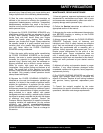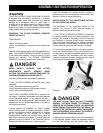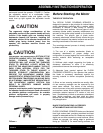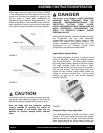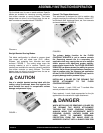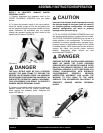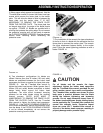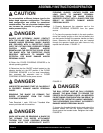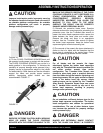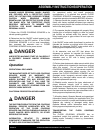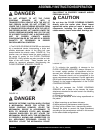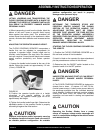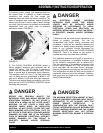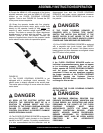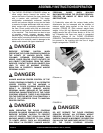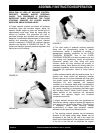
ASSEMBLY INSTRUCTIONS/OPERATION
SFCS-16 OPERATION AND PARTS MANUAL REV #3 (02/23/06) PAGE 18
CAUTION
Improper knob tension and/or improperly securing
the operator handle to the main frame can result in
an unstable platform configuration. An unstable
platform configuration can result in property
damage and/or personal injury.
FIGURE 16
4) Tilt the FLOOR COVERING SCRAPER back until
the operator handle comes in contact with the surface.
The FLOOR COVERING SCRAPER may not be in a
stable position in this configuration. To minimize the
possibility of property damage and/or personal injury,
properly secure an appropriate weight to the handle
for added stability. Other means can also be utilized to
support the frame and provide proper machine
stability. Appropriate wheel chocks are also
recommended. FIGURE 17.
FIGURE 17
DANGER
EXERCISE EXTREME CAUTION WHEN WORKING
NEAR OR UNDER THE FLOOR COVERING
SCRAPER WITH THE OPERATOR HANDLE TILTED
BACK IN THE SERVICE POSITION. IF THE FLOOR
COVERING SCRAPER IS NOT POSITIONED IN A
STABLE CONFIGURATION, WITH ADEQUATE
COUNTERWEIGHT PROPERLY SECURED,
UNEXPECTED MOVEMENT CAN ALLOW THE
MACHINE TO FALL BACK TO THE WORK
SURFACE. THE RESULT CAN BE PROPERTY
DAMAGE AND/OR PERSONAL INJURY.
5) Reinstall the protective blade cover. Exercise
extreme caution when removing and/or reinstalling the
protective cover. Use the T-handled Allen wrench to
loosen the button head capscrews which secure the
blade between the fence plate and exciter plate.
Remove the blade and store in an appropriate
location. Use the T-handled Allen wrench to tighten
the button head capscrews. Keep the button head
capscrews tight to minimize becoming lost.
6) The removal of the ceramic tile ripper attachment is
similar to that of a blade with the exception that the
fence plate is reinstalled to the exciter plate. Follow
the same tightening procedure as with a blade.
CAUTION
For all blades and the ceramic tile ripper
attachment, tighten the button head capscrews
only with the T-handled Allen wrench provided. Do
not utilize another wrench type and/or
configuration. The T-handled Allen wrench was
chosen to place body parts a practical distance
from the blade during the fastener tightening and
loosening process. Do not apply excessive impact
force to the button head cap screws. Ample
seating torque can be applied by the T-handled
Allen wrench. Excessive impact force can cause
the T- handled Allen wrench to slip out of the
button head capscrew, resulting in property
damage and/or personal injury.
CAUTION
Do not substitute a different fastener type for the
button head capscrew configuration. The button
head configuration was chosen for operational
considerations. The use of other fastener types
can increase the potential for property damage
and/or personal injury.
DANGER
BLADES ARE EXTREMELY SHARP. CONTACT
WITH THE BLADE CAN RESULT IN PROPERTY



